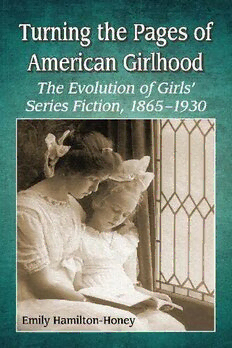
Turning the Pages of American Girlhood: The Evolution of Girls' Series Fiction, 1865-1930 PDF
Preview Turning the Pages of American Girlhood: The Evolution of Girls' Series Fiction, 1865-1930
Turning the Pages of American Girlhood This page intentionally left blank Turning the Pages of American Girlhood The Evolution of Girls’ Series Fiction, 1865–1930 E H -H MILY AMILTON ONEY McFarland & Company, Inc., Publishers Jefferson, North Carolina, and London LIBRARYOFCONGRESSCATALOGUING-IN-PUBLICATIONDATA Hamilton-Honey, Emily. Turning the pages of American girlhood : the evolution of girls’ series fiction, 1865–1930 / Emily Hamilton-Honey. p. cm. Includes bibliographical references and index. ISBN 978-0-7864-6322-0 softcover : acid free paper 1. Children’s stories, American—History and criticism. 2. Girls in literature. 3. Girls—Books and reading— United States—History—19th century. 4. Girls— Books and reading—United States—History—20th century. 5. Children’s literature in series—History and criticism. 6. Serialized fiction—United States— History and criticism. 7. American fiction—19th century—History and criticism. 8. American fiction—20th century—History and criticism. I. Title. PS374.C454H36 2013 813'.5099282—dc23 2012049419 BRITISHLIBRARYCATALOGUINGDATAAREAVAILABLE © 2013 Emily Hamilton-Honey. All rights reserved No part of this book may be reproduced or transmitted in any form or by any means, electronic or mechanical, i ncluding photocopying or recording, or by any information storage and retrieval system, without permission in writing from the publisher. On the cover: Girls from 1800s with book (iStockphoto/Thinkstock) Manufactured in the United States of America McFarland & Company, Inc., Publishers Box 611, Jefferson, North Carolina 28640 www.mcfarlandpub.com For Nick. I never would have made it this far without you. This page intentionally left blank Table of Contents Acknowledgments ix Introduction 1 ONE. Learning to Be an Angel: Religion and Reading for Nineteenth-Century American Girls 25 TWO. Angels in the House: Christian Womanhood and Community Power in Postbellum Girls’ Series 54 THREE. A Revolution in Series Production: Edward Stratemeyer and the Commodification of Series Books 84 FOUR. Communities of Friends: Series Heroines as Consumers, 1901–1930 104 FIVE. Two Miles Forward, One Mile Back: Gender Battles During the Great War 135 SIX. Running the Gamut and the Gauntlet: World War I Series Fiction as a Catalyst for Change in the Cultural Landscape of American Girlhood 169 SEVEN. Taking Advantage of New Markets: Ruth Fielding as a Motion Picture Screenwriter, Producer, and Executive 201 Conclusion: Nancy Drew and a New Era 223 Appendix: Series Books in Order of Publication 233 Bibliography 237 Index 251 vii This page intentionally left blank Acknowledgments Deborah Carlin, Joyce Berkman, Laura Lovett, and Randall Knoper, of the University of Massachusetts, Amherst, deserve more thanks than I can ever express in such a small space. They believed in this project from the beginning, they let me run with it and reshape it several times over, they reined me in when necessary, and most importantly, they made me a better and more careful writer and scholar. They willingly helped me negotiate the difficult balance of rigorous literary analysis and historical proof that is often required of American Studies researchers; they also allowed me to find creative ways of documenting and dealing with this mostly-uncharted territory of nineteenth-century series. Thank you all for being such a supportive and enthusiastic dissertation committee. I am grateful to Northern Illinois University for providing me with a Horatio Alger, Jr. Fellowship to travel to their collection. Their monetary support allowed me to spend a wonderful week examining original Alcott, Finley, and Champney volumes, as well as the William Thayer advice manual that came in handy at a crucial moment. The NIU curator, Lynne Thomas, has been a wonderful source of support and information as well as a lovely new friend. Thanks must also be given to the librarians of the Manuscripts and Archives Division at the New York Public Library, Stephen A. Schwarzman Building. They were incredibly helpful both before and during my week-long stay in New York, and helped me navigate the mountains of material from the Stratemeyer Syndicate with a great deal of patience and many smiles. James Keeline has been unfailingly kind and generous with both his own work and his critiques during the writing of this project. His research on Edward Stratemeyer (much of it unpublished) has been absolutely invaluable, and he took the time to point out many small errors and clarify many details about Stratemeyer’s methods and the operations of the Syndicate. ix
